Razer Blade 14-Inch Gaming Notebook Review
by Dustin Sklavos on July 2, 2013 1:00 PM ESTDisplay Quality
It's unfortunate that one of the hallmarks of Windows notebooks seems to be that the vendor can get almost everything right, and then have one massive, gaping flaw. Unfortunately this remains true of the Razer Blade 14-inch as well. While the Blade has incorporated some of the best elements of Apple notebook design, they neglected to include one of the biggest and most important reasons why people will buy MacBooks: display quality.
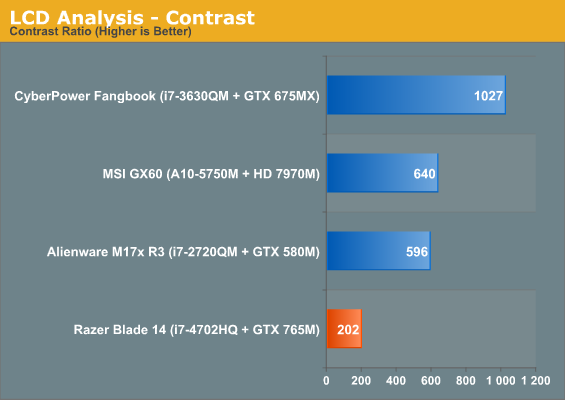
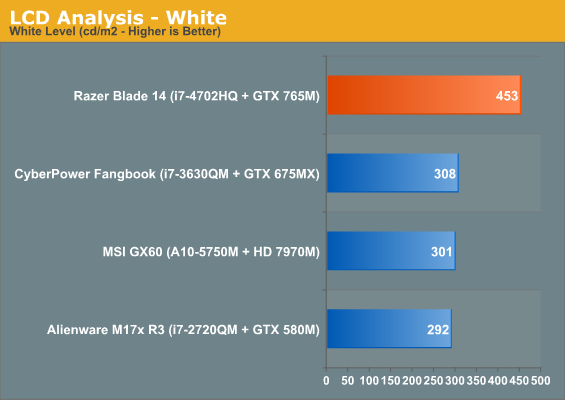
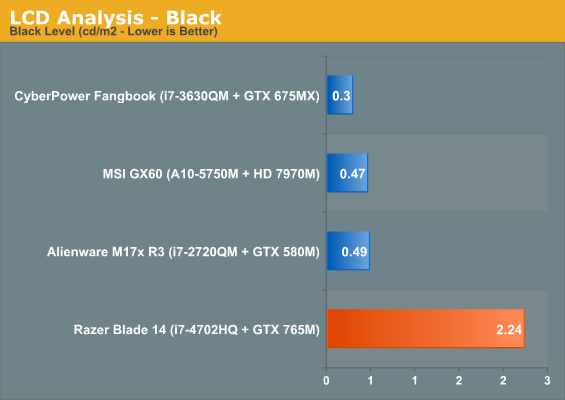
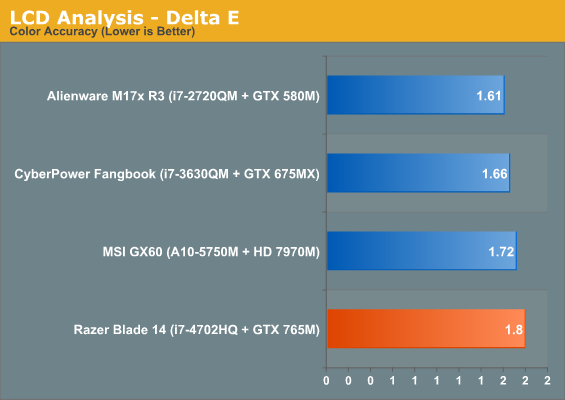
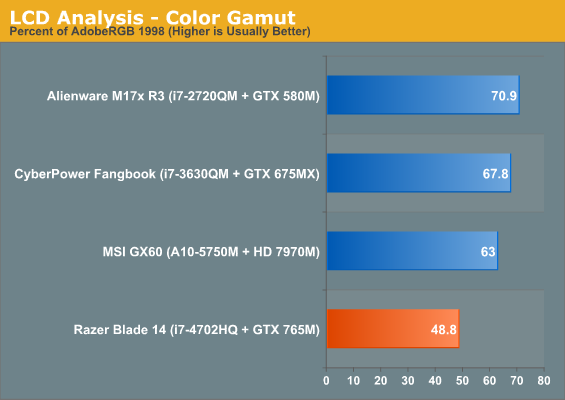
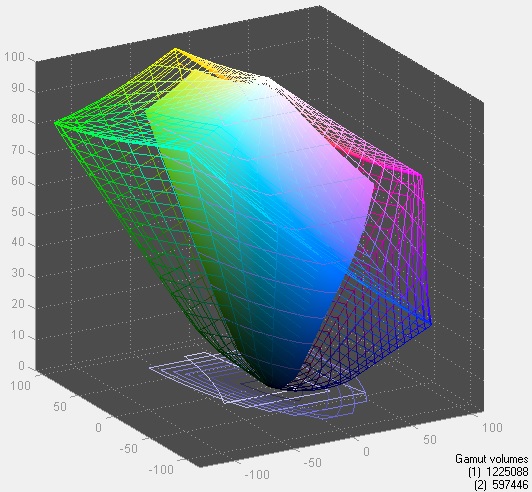
The Razer Blade 14-inch may be enjoying a 1600x900 resolution that's perfect for the gaming hardware included within, but the panel itself is atrocious. Razer was able to jack up the brightness to a respectable 453 nits, but it's a linear boost: the black level is a heinous 2.24 nits. There's just no excuse for this; Lenovo was able to get a 14", 1600x900 panel in their X1 Carbon that walks all over the Blade's. And Alienware is offering a 1080p IPS panel on their Alienware 14, a notebook that may be thicker but offers the same GPU, an optical drive, and a faster CPU. I was stunned by the Blade's beautiful design, and I was equally stunned by its dire screen quality, which suffers from the same nasty "no correct viewing angle" problem that cheap TN panels typically do.
Battery Life
It's hard to generate much enthusiasm for the Razer Blade 14-inch after discovering how poor the display quality on it is, but the flipside is that the battery life on it is pretty impressive. Razer was able to cram a 70Wh battery into the Blade, and leveraging the 37W quad-core and NVIDIA's Optimus allows them to eke out a healthy amount of mobility.

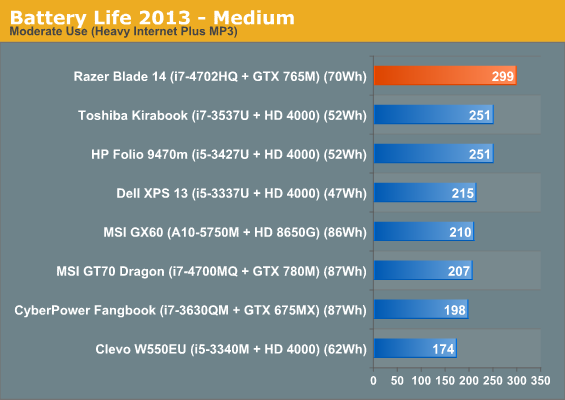
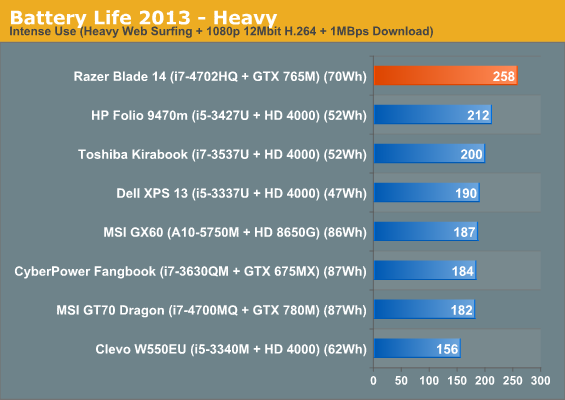
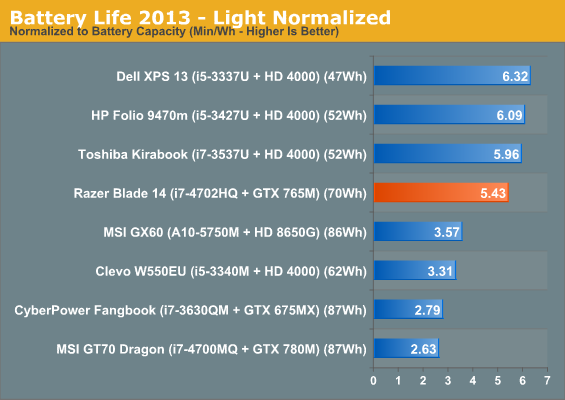

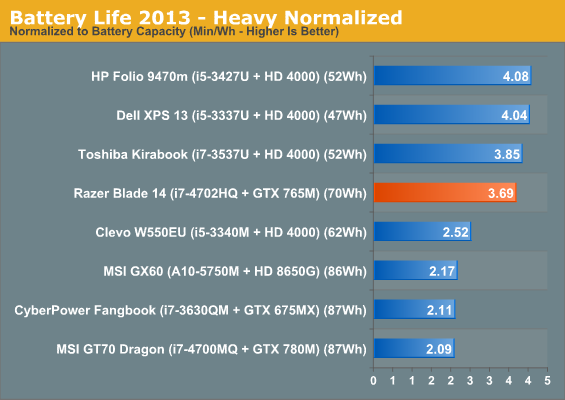
This is, without a doubt, a gaming ultrabook. Normalized power consumption is practically in line with full-on ultrabooks from the last generation sporting ULV processors, but Razer is able to do it with a full quad-core CPU and a beefy GPU (that turns off when not in use, naturally).
Heat and Noise
Razer was able to handle the balancing act of heat, noise, and chassis bulk with remarkable skill. I'm not sure they hit the absolute sweet spot, but they're awfully close to it. Fan noise is sub-40dB under load, which is actually pretty excellent for a gaming notebook. They're definitely playing "Thermal Chicken" with the surface temperatures, but unless you mash your giant hand down on the keyboard or keep poking the hinge with your fingertip (where most of the heat is), you're not going to be too uncomfortable.

The CPU temperatures definitely get up there and Razer is pretty close to playing with fire here, but in practice I found the system was ultimately able to handle thermals fairly well. If anything I feel like Razer has some room to improve here; I think they could spin up the fan on the CPU without having too negative an impact on system noise. Heat density is going to be much higher in the i7-4702HQ than it is in the GTX 765M; the 765M has 2.54 billion transistors on a 28nm process, and a good chunk of those transistors have been shut off. Meanwhile the i7-4702HQ 1.4 billion transistors on a 22nm process, and that's ignoring the marginal heat that's going to be produced by the on-package chipset.
I think there's still a little room for improvement here, and I'm never happy to see CPU core temperatures in the 90s, but it's not hitting throttling temperatures. Just remember that this notebook must take cool air in from the bottom. Other ultrabooks I'm a bit more critical of when they have bottom-intake cooling systems, but the Blade is handling 100W+ of silicon.










108 Comments
View All Comments
Khenglish - Wednesday, July 3, 2013 - link
One thing I would like to see more detail on for gaming laptops is temperatures. Cooling is a huge issue for gaming laptops.What program got you to 93C? What was the room temp? If you got to 93C after running linpack an hour, then 93C is fine. If you got to 93C from 3dm11's physics test, then we have a problem. Can you confirm that there was no throttling? Haswell's throttle point is not until 100C, but sometimes the BIOS will trigger early throttling, or do something like disable turbo if the dGPU is active.
Same story for gpu temps. Just loop one of the unigen benchmarks for an hour or something.
damianrobertjones - Wednesday, July 3, 2013 - link
"While the Blade has incorporated some of the best elements of Apple notebook design" - Apple was not the first to release a thin laptop or to use the chiclet keyboard so why do web sites like this keep on pushing these thoughts? It instantly places the machine, in readers minds, as being somewhat negative.VLSImagic - Wednesday, July 3, 2013 - link
Probably because when you put this directly next to an Apple rMBP 15", then you're looking at something that, shall we say, was 'inpired' by the Apple in terms of its design. And its not just on the outside either, checkout the 15" rMBP motherboard in this picture and then compare it to the Blade's internals in the article:http://www.extremetech.com/wp-content/uploads/2012...
augustofretes - Friday, July 5, 2013 - link
You apple deniers need to grow up, Apple invented the ultrabook, ultrabooks exist because they were and are a response to Apple's Macbook Air, they launched that while the industry was high on Netbooks...Steveymoo - Wednesday, July 3, 2013 - link
What an archaic pricing scheme - The system uses 3 variants of the samsung 840 SSD (admittedly gutted and custom fitted, but still.) As far as I can see, there is only around a $200 difference between the 128gb, and 500gb variants of this SSD. So apart from blatant profiteering, where are they getting the $400 mark-up in price from?SpeedyGonzales - Wednesday, July 3, 2013 - link
...out of their asses. Base configuration upgrades such as RAM, SSD and GPU upgrades are usually used to rip-off customers. See: Alienware, Razer, Apple...to a certain extend the Clevo resellers as well, but not as drastic.Terrestrial - Wednesday, July 3, 2013 - link
Anand, what do you think about Min's post on Facebook about the panel on the Blade, reprinted below:I’ve been asked many times why we chose a TN panel over an IPS panel for the Razer Blade and my response has been “It’s the best 14” panel available for gaming.” I thought I’d go into it in greater detail.
The TN panel on the Razer Blade has a transition time of 8ms (16ms worst case) and essentially, that means that pixels can completely turn on or off within the refresh time allotted in a 60Hz display. The IPS panels available to us at the time had a refresh rate of 35ms (50ms worst case) and basically that means there could be visible artifact during pixel transitions from any one color to another.
The difference between 50ms and 16ms means that we can avoid any chance of visible artifact during quickly changing frames, i.e. gaming performance is best on the panel we chose.
However, admittedly, while gaming performance is better on the panel we chose, other issues like vertical viewing angles are poorer for the TN panel as compared to IPS panels.
We made these decisions well aware that it would have an impact on other uses – i.e. lying in bed and watching a movie with a friend etc, but it has always been gaming first here at Razer. Honestly, from my own personal perspective, I don’t have any issues with viewing angles cos I’m forever alone on my laptop anyway.
This is akin to the decision that we made for the first Razer Blade Pro 2 years ago where we picked a dual-core CPU with a higher clock rate vs a quad-core CPU with a lower clock rate. For the tech uninitiated then, most said “why not Quad core?” but the hardcore gamers understood that a higher clock speed dual core CPU would outperform a lower clock speed quad core for gaming. It was only till the Quad Core CPUs met our gaming spec that we moved to a Quad Core CPU. Similarly, when it came to screen selection for the new Razer Blade, we picked the 14” best screen there was for gamers.
Would we pick an IPS panel in the future? Possibly, but only if the refresh rates are up to par with our expectations for our customers – you – the gamer. Until then, the 14” TN panel is the best panel there is for gaming.
Our design philosophy has always been to design and build the best possible products for gamers. And that will never change!
SpeedyGonzales - Wednesday, July 3, 2013 - link
@TerrestrialI think gamers are willing to compromise on viewing angles, maybe on colour gamut as well, but not on black levels.
Focusing on response time only, does not help, if dark gaming scenes are rather grey.
Are you telling us, that there is no 1600*900 TN panel available with a black level less than 0,5 ?
What is needed is a TN panel with a contrast ratio of at least 600 and a color gamut of 68+, in this case gamers will compromise on viewing angels.
At this price point this panel makes the entire Laptop obsolete, because dark scenes will be "unplayable", regardless of screen response time.
Whilst talking about design decisions, the Razer Blade pro, with its 1080p resolution is underpowered. All tests so far show, that the GTX765 is massively bandwidth limited and therefore not future proof at a native 1080p resolution.
Both laptops look very nice and I would be willing to pay the Razer premium, even for the 500GB SSD, but not with such bad design compromises.
processinfo - Wednesday, July 3, 2013 - link
Crap, I was thinking about buying one but with this display forget about it.Crappy TN pannel in $2000 machine! What are they thinking?!!
evilspoons - Wednesday, July 3, 2013 - link
Well, I was hoping to buy this as a replacement for my dead Macbook Pro. I primarily use my laptop for Photoshop Lightroom, but with a display that terrible there's no way in hell they're getting my money. What a huge loss... I'd easily pay another $200 to have a proper IPS panel in this thing.